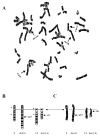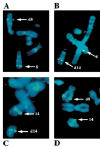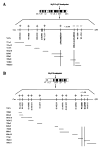Identification and molecular characterization of de novo translocation t(8;14)(q22.3;q13) associated with a vascular and tissue overgrowth syndrome
- PMID: 12063397
- PMCID: PMC1579861
- DOI: 10.1159/000059343
Identification and molecular characterization of de novo translocation t(8;14)(q22.3;q13) associated with a vascular and tissue overgrowth syndrome
Abstract
Klippel-Trenaunay syndrome (KTS) is a disorder primarily characterized by capillary-venous vascular malformations associated with altered limb bulk and/or length. We report the identification of a balanced translocation involving chromosomes 8q22.3 and 14q13 in a patient with a vascular and tissue overgrowth syndrome consistent with KTS. We demonstrated that translocation t(8;14)(q22.3;q13) arose de novo. These data suggest that a pathogenic gene for a vascular and tissue overgrowth syndrome (KTS) may be located at chromosome 8q22.3 or 14q13. Fluorescence in situ hybridization (FISH) analysis was used to define the breakpoint on chromosome 8q22.3 to a <5-cM interval flanked by markers AFMA082TG9 and GATA25E10, and the 14q13 breakpoint within a 1-cM region between STSs WI-6583 and D14S989. This study provides a framework for the fine-mapping and ultimate cloning of a novel vascular gene at 8q22.3 or 14q13.
Copyright 2002 S. Karger AG, Basel
Figures





References
-
- Aelvoet GE, Jorens PG, Roelen LM. Genetic aspects of the Klippel-Trenaunay syndrome. Br J Dermatol. 1992;126:603–607. - PubMed
-
- Bangs CD, Donlon TA. Chromosome preparation from cultured peripheral blood cells. In: Dracopoli NC, Haines JL, Korf BR, Moir DT, Morton CC, Seidman CE, Seidman JG, Smith DR, Boyle ALB, editors. Current Protocols in Human Genetics. John Wiley & Sons, Inc.; New York: 1996. pp. 4.1.1–4.1.19. - PubMed
-
- Berry SA, Peterson C, Mize W, Bloom K, Zachary C, Blasco P, Hunter D. Klippel-Trenaunay syndrome. Am J med Genet. 1998;79:319–326. - PubMed
-
- Biesecker LG, Happle R, Mulliken JB, Weksberg R, Graham JM, Jr, Viljoen DL, Cohen MM., Jr Proteus syndrome: diagnostic criteria, differential diagnosis, and patient evaluation. Am J med Genet. 1999;84:389–395. - PubMed
-
- Ceballos-Quintal JM, Pinto-Escalante D, Castillo-Zapata I. A new case of Klippel-Trenaunay-Weber (KTW) syndrome: evidence of autosomal dominant inheritance. Am J med Genet. 1996;63:426–427. - PubMed
Publication types
MeSH terms
Substances
Grants and funding
LinkOut - more resources
Full Text Sources
